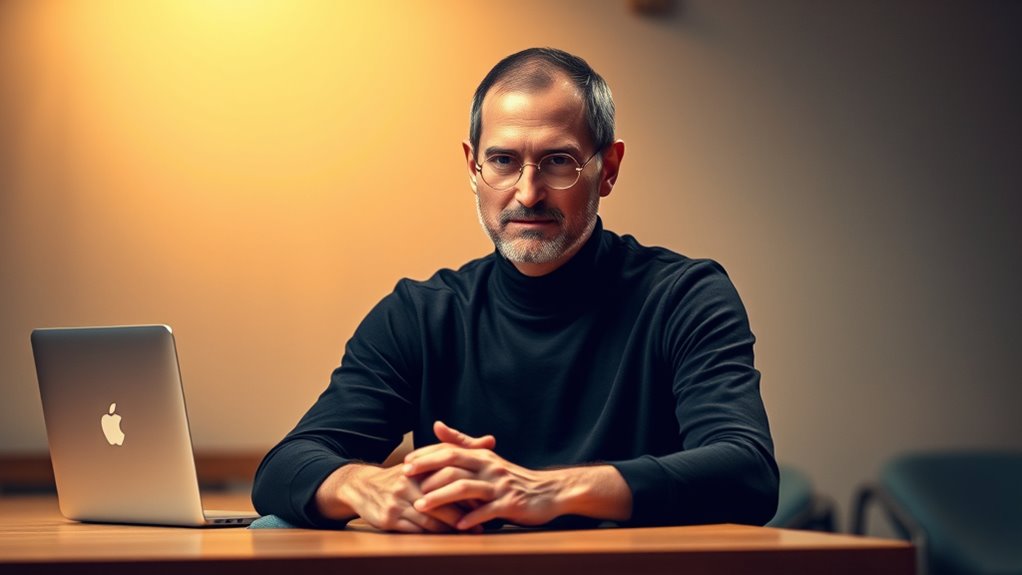Steve Jobs believed that those willing to challenge norms and think differently can change the world. His innovative mindset fueled revolutionary products like the iPhone and MacBook, shaping industries and inspiring others to push boundaries. His leadership style was hands-on, passionate, and sometimes confrontational, fostering a culture of dedication and excellence. By embracing bold ideas and questioning convention, Jobs showed that radical thinking and relentless pursuit can lead to profound, global impact—if you explore further, you’ll discover what made this possible.
Key Takeaways
- Steve Jobs believed that crazy ideas challenge the status quo and can revolutionize industries.
- His innovative mindset fostered revolutionary products like the iPhone and MacBook, transforming markets.
- Jobs’ leadership style inspired teams to pursue excellence through relentless passion and clear vision.
- He created a culture that valued questioning norms, pushing boundaries, and disciplined execution.
- His legacy shows that daring, unconventional thinking can lead to global change and technological evolution.

Steve Jobs was a visionary entrepreneur whose innovations transformed the way we communicate, work, and entertain ourselves. His ability to see beyond the present and imagine a future shaped by sleek, intuitive technology set him apart. As you study his journey, you realize that his innovation mindset wasn’t just about inventing gadgets; it was about challenging the status quo and constantly pushing boundaries. Jobs believed in thinking differently, encouraging his teams to approach problems with fresh perspectives and daring ideas. He fostered a culture where questioning convention was not only accepted but celebrated—this mindset fueled groundbreaking products like the iPhone and MacBook that changed entire industries.
Steve Jobs’s innovation mindset challenged norms and inspired revolutionary products that transformed entire industries.
When it comes to leadership style, Jobs was intensely hands-on and uncompromising. You might think leadership is about delegation or consensus, but his approach was more about inspiring relentless pursuit of excellence. He wasn’t afraid to be direct or even confrontational if it meant achieving a higher standard. His style was charismatic yet demanding; he motivated his teams by setting a compelling vision and demanding they believe in it wholeheartedly. Jobs knew that to innovate at the highest level, you need a leader who can challenge others to think bigger and act boldly. His style also emphasized the importance of effective communication in inspiring teams and aligning their efforts toward shared goals.
Moreover, his ability to blend an innovation mindset with his distinctive leadership style created a unique environment. You see, Jobs understood that revolutionary ideas stem not only from creative thinking but also from disciplined execution. His insistence on quality and simplicity became hallmark traits that defined Apple’s brand. He pushed his teams to go beyond incremental improvements and aim for iconic, transformative products. His leadership style emphasized focus, clarity, and passion—traits that inspired loyalty and dedication among his employees.
As you reflect on Jobs’s approach, you realize that his success came from a relentless belief that seemingly crazy ideas could change the world. His innovation mindset didn’t just lead to new products; it reshaped entire markets. His leadership style, though sometimes tough, created a culture where innovation thrived because everyone was committed to a shared vision of excellence. If you want to emulate his success, it starts with adopting a mindset that welcomes challenge and a leadership approach that inspires others to see possibilities where others see obstacles. That’s how Steve Jobs turned “crazy enough” into a force capable of transforming the world.
Frequently Asked Questions
What Inspired Steve Jobs’ Innovative Approach to Product Design?
Your creative inspiration for product design came from a desire to make technology simple and beautiful, reflecting a unique design philosophy. You believe that innovation starts with understanding user needs deeply, which fuels your passion. By challenging conventions and thinking differently, you focus on elegant, intuitive designs. This approach pushes you to create products that aren’t just functional but also inspiring, changing how people interact with technology every day.
How Did Steve Jobs’ Leadership Style Influence Apple’s Company Culture?
You’ll notice that Steve Jobs’ leadership style deeply shaped Apple’s company values, emphasizing innovation, perfection, and boldness. His leadership philosophy encouraged creativity and risk-taking, fostering a culture where thinking differently was celebrated. This coincidence of vision and action inspired employees to push boundaries, fueling Apple’s success. By setting high standards and leading by example, you’re motivated to embrace new ideas and contribute to a dynamic, forward-thinking environment.
What Were Steve Jobs’ Biggest Challenges During Apple’s Early Years?
You face major challenges like funding struggles and fierce market competition during Apple’s early years. Securing enough capital was tough, and breaking into the dominant tech industry wasn’t easy. You had to innovate constantly and stand out against established giants. These obstacles tested your resilience, pushing you to develop groundbreaking products that would eventually revolutionize technology and reshape the company’s future.
How Did Steve Jobs’ Personal Life Impact His Professional Decisions?
Your personal relationships and emotional well-being often played a tricky game of tug-of-war with your professional decisions. When your personal life was chaotic, it fueled your relentless drive or led to impulsive choices. You thrived on intense emotions, sometimes sacrificing balance for innovation. Your personal struggles pushed you to innovate harder, but they also risked clouding your judgment—making the line between genius and chaos blurrier than a spilled coffee on an iPhone.
What Legacy Has Steve Jobs Left for Future Entrepreneurs?
You’re inspired by Steve Jobs’ legacy of entrepreneurial resilience and creative risk-taking. His ability to innovate despite setbacks teaches you to stay persistent and embrace bold ideas. By pushing boundaries and trusting your vision, you learn that failure is part of growth. His example reminds you to think differently, take calculated risks, and never settle—empowering you to change the world just as he did.
Conclusion
Remember, it’s the dreamers who gently push the boundaries of what’s possible, often quietly reshaping the world in ways others might overlook. Like a soft ripple spreading through calm waters, their bold ideas ripple outward, inspiring change without fanfare. So, stay curious and daring—sometimes, it’s the quiet, persistent whispers of those “crazy enough” to believe that truly transform the world, leaving behind a subtle, lasting legacy.
Joy, as our Editor in Chief, ensures the highest standard of content. Her talent in writing is complemented by her attention to detail and passion for literature and culture. Joy’s expertise and love for the English language shine through in her editorial work, making each piece a testament to quality and clarity.










